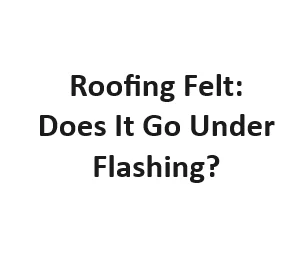When it comes to roofing, there are numerous components that work together to ensure your home stays dry and protected from the elements. One crucial element often discussed in roofing installations is roofing felt. But where does roofing felt fit into the equation, especially when it comes to flashing? In this blog post, we’ll explore the role of roofing felt in roofing systems and whether it should go under flashing.
Understanding Roofing Felt
Before we dive into the question of whether roofing felt should be placed under flashing, let’s get a clear understanding of what roofing felt is and why it’s used in roofing projects.
1. What Is Roofing Felt?
Roofing felt, also known as tar paper or underlayment, is a material commonly used in roofing to provide an additional layer of protection between the roofing materials and the underlying structure of a building. It is typically made of asphalt-saturated felt or synthetic materials, and it comes in rolls.
2. The Purpose of Roofing Felt
Roofing felt serves several essential functions in roofing systems:
A. Waterproofing:
One of the primary purposes of roofing felt is to act as a waterproof barrier. It prevents water from infiltrating the roof deck and causing damage to the structure of your home.
B. Protection:
Roofing felt offers an extra layer of protection against various environmental factors, including wind-driven rain, snow, and debris. It also helps to prevent the growth of mold and mildew.
C. Temperature Regulation:
Roofing felt can assist in regulating temperature by providing insulation, reducing heat transfer, and enhancing energy efficiency.
Now that we have a solid understanding of roofing felt let’s move on to the main question:
A Synergistic Relationship
Flashing is another crucial component of a roofing system. It’s typically made of metal or other durable materials and is installed in vulnerable areas of the roof to prevent water from seeping in. These vulnerable areas include roof valleys, chimneys, skylights, and roof-to-wall connections. So, should roofing felt be placed under flashing?
1. Roofing Felt Beneath Flashing
In most roofing installations, it’s common practice to install roofing felt beneath flashing. Here’s why:
A. Added Waterproofing:
Placing roofing felt under flashing enhances the waterproofing capability of the roofing system. Even if water were to somehow bypass the flashing, the roofing felt would act as an additional barrier, preventing moisture from reaching the underlying structure.
B. Improved Leak Protection:
Flashing is not immune to wear and tear over time. If it were to develop any cracks or vulnerabilities, the roofing felt underneath can provide an extra layer of protection against leaks until repairs can be made.
C. Seamless Integration:
Roofing felt is typically installed across the entire roof deck before flashing is added. This seamless integration ensures that all areas of the roof, including those protected by flashing, have an added layer of defense against water intrusion.
2. Roofing Felt on Top of Flashing?
Some homeowners and contractors may wonder if it’s necessary to place roofing felt on top of flashing. While this isn’t standard practice, there are situations where it might be considered:
A. Custom Design:
In unique roofing designs or special circumstances, roofing professionals may opt to install roofing felt on top of flashing. This is done to create a custom waterproofing solution tailored to the specific needs of the project.
B. Extra Protection:
In regions with extreme weather conditions, such as heavy rainfall or snow, some contractors may choose to add an extra layer of protection by installing roofing felt over flashing as an additional safeguard.
Important Considerations for Roofing Felt and Flashing Installation
1. Proper Material Selection:
Both roofing felt and flashing materials play pivotal roles in the longevity and performance of your roof. When selecting roofing felt, opt for high-quality materials that are durable and can withstand the local weather conditions. Similarly, choose flashing materials that are corrosion-resistant and compatible with your roofing material.
2. Professional Installation:
Roofing felt and flashing should always be installed by experienced professionals who are well-versed in roofing techniques. Improper installation can lead to leaks and structural damage down the line, so it’s essential to invest in skilled labor for your roofing project.
3. Flashing Design:
The design and placement of flashing are critical. Properly designed flashing should overlap roofing felt and be integrated seamlessly into the roofing system. It should divert water away from vulnerable areas, such as valleys and intersections with walls or chimneys.
4. Roof Pitch:
The pitch or slope of your roof can influence how water flows and where it’s likely to accumulate. Roofing felt and flashing should be installed with the roof pitch in mind to ensure effective water shedding.
5. Climate Considerations:
The climate in your region should also influence decisions regarding roofing felt and flashing. Areas with heavy rainfall or snowfall may require extra precautions and more robust waterproofing measures. Consult with local roofing experts who understand the specific challenges of your climate.
6. Regular Inspections and Maintenance:
After your roofing system is installed, it’s crucial to schedule regular inspections and maintenance to check for any signs of wear and tear. Flashing can deteriorate over time, and roofing felt may need replacement if it becomes damaged or loses its effectiveness.
7. Building Codes and Regulations:
Compliance with local building codes and regulations is non-negotiable when it comes to roofing installations. These codes often specify the type and placement of roofing materials, including roofing felt and flashing. Ensure that your roofing project adheres to all relevant codes to avoid potential legal and insurance issues.
Components of a Roofing System
| Component | Purpose |
|---|---|
| Roofing Felt | Acts as a secondary moisture barrier |
| Flashing | Diverts water away from vulnerable areas |
| Roof Shingles | Protects against weather and aesthetics |
| Roof Decking | Provides structural support for roofing |
| Ventilation System | Regulates temperature and moisture |
Roofing Felt vs. Flashing
| Property | Roofing Felt | Flashing |
|---|---|---|
| Material | Typically asphalt-saturated felt paper | Metal, rubber, or other flashing materials |
| Location | Installed across the entire roof deck | Placed at vulnerable points (e.g., chimney, valleys) |
| Purpose | Acts as a moisture barrier and protects the roof deck | Prevents water infiltration at specific areas |
| Water Resistance | Resistant to water but not entirely waterproof | Designed to be completely waterproof |
| Application | Installed under roofing materials | Applied around roof penetrations |
Pros of Using Roofing Felt Under Flashing
| Benefits | Explanation |
|---|---|
| Extra Protection | Adds an additional layer of moisture resistance under flashing |
| Enhanced Durability | Helps prevent water-related damage to the roof deck |
| Versatility | Can be used with various roofing materials and flashing types |
Cons of Using Roofing Felt Under Flashing
| Drawbacks | Explanation |
|---|---|
| Potential Trapping | If not installed correctly, it may trap moisture between layers |
| Increased Cost | Adds to the overall cost of the roofing system |
Best Practices for Roofing Felt and Flashing Installation
| Installation Tips | Details |
|---|---|
| Proper Overlap | Ensure proper overlap of roofing felt and flashing to prevent leaks |
| Secure Attachment | Use appropriate fasteners and adhesives for a secure installation |
| Regular Inspection | Periodically inspect and maintain both roofing felt and flashing to detect any issues |
Wrapping Up
In conclusion, roofing felt and flashing are essential components of a well-designed and functional roofing system. Roofing felt provides an extra layer of waterproofing and protection, while flashing redirects water away from vulnerable areas. While roofing felt is typically installed beneath flashing, there can be exceptions depending on specific project requirements.
To ensure the longevity and effectiveness of your roofing system, prioritize proper material selection, professional installation, and regular maintenance. By doing so, you can have confidence that your roof will continue to protect your home from the elements for years to come.
If you have any more questions or need further guidance on roofing-related topics, don’t hesitate to reach out to roofing professionals in your area. They can provide tailored advice based on your specific needs and regional considerations.
Remember, a well-maintained roof is an investment in the comfort and safety of your home, and it’s worth the effort to ensure it’s done right.


